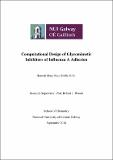| dc.description.abstract | Many pathogens, such as avian influenza, Helicobacter pylori and Streptococcus pneumoniae, employ cell-surface glycans which terminate in Neu5AcAlpha(2-3)Gal as their adhesion partner.[1] As a result, a glycomimetic anti-adhesive drug based on this structure could potentially prevent infection.
In this project, sialylated galactose (Neu5AcAlpha(2-3)Gal) is employed as a scaffold in the design of high-affinity inhibitors of influenza A virus adhesion. Advanced computational methods are employed to focus the number of glycomimetic synthetic targets to a select few that have the highest probability to block influenza adhesion and infection. Several identified glycomimetic lead scaffolds have been synthesised and their ability to bind avian influenza haemagglutinin is being assayed, at time of writing, using bio-layer interferometry. In addition to the glycomimetic targets initially identified, some synthetic intermediates (from the glycomimetic synthetic pathway) have also been subjected to computational study to assess their suitability as influenza inhibitors.
There are few computational tools parameterized or validated for use in glycomimetic design, leading to the need in this study to evaluate the applied computational methods. The computational methods used include molecular dynamics (MD) and molecular mechanics - Poisson Boltzmann surface area (MM-PBSA) calculations.
MM-PBSA is used to estimate the binding free energy. Substituent remodelling was carried out using BOMB to scan libraries containing over 500 drug-like substituents.[2] The ability of these techniques to reproduce experimental observables was also assessed, using a test case of galectin-3 inhibitors with known experimental binding results. In this case BOMB was better able to rank the inhibitors according to their binding affinity. Also assessed was the suitablity of GAFF (General Amber Force Field) to simulate glycans and glycomimetics.
1. Ofek, I.; Hasty, D. L.; Sharon, N., Anti-Adhesion Therapy of Bacterial Diseases: Prospects and Problems. FEMS Immunol. Med. Microbiol. 2003, 38 (3), 181-191.
2. Barreiro, G.; Kim, J. T.; Guimaraes, C. R. W.; Bailey, C. M.; Domaoal, R. A.; Wang, L.; Anderson, K. S.; Jorgensen, W. L., From Docking False-Positive to Active Anti-HIV Agent. J. Med. Chem. 2007, 50 (22), 5324-5329. | en_US |


